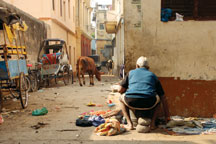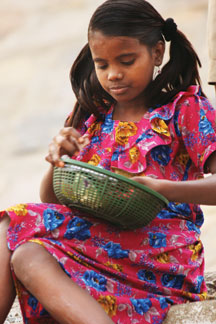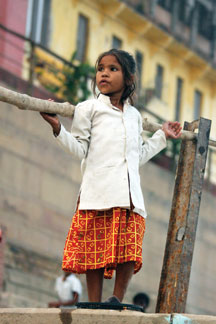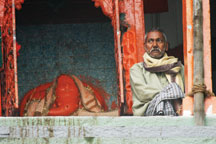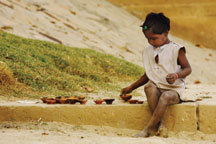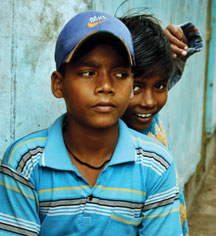Arts
Varanasi Sacred & Profane

The cricket game, like everything else in Varanasi, carries on amidst the funeral chants and the grieving.
|
My first hour in Varanasi gave me a good taste of the city. A dozen kids were playing cricket close to the Hanuman Ghat along the Ganges. They had drawn the wickets with white chalk against a temple wall. A high ball dropped behind the temple. I was busy photographing them at the game, when the bowler casually called out for me to fetch the ball. I obeyed and found it floating on the edge of the river. As I bent to pick it up, I realized it was covered in ash.
Three fires were smoldering close by. To my utter shock I realized three cremations were underway. I stood flabbergasted staring at the funeral pyre barely a foot away from me, as the ash-covered ball in my hand dripped water. A player shouted for the ball and I turned, distressed that I may have unknowingly trampled on a sacred site. The boy took the ball, thumped it on the ground a few times to shed the water and threw it back into play. Anywhere else death is treated with trepidation and reverence. In Varanasi, the city synonymous with death, where devout Hindus are cremated, I was shaken by the sight of pedestrians moving about their daily chores as plumes of smoke rose from funeral pyres all around them. The cricket game, like everything else in the city, simply carried on amidst the funeral chants and the grieving. Over the course of my stay in the city, I often found myself participating in the cricket games in the ghats, as occasionally did other tourists to the sacred river.
The Ghats of Shiva’s City For centuries, Hindus have come to the ghats of the Ganges to spend their final days in the belief that a soul finds its way to heaven when life ends on its steps. In today’s frenetic world, few are willing to forsake worldly pleasures and live a shamanic life; but the truly devout nonetheless desire at least to be cremated there. Changing times and fading traditions often disappoint, but not in this city. Tradition is scattered all over the city as the new and the old fuse together. I frequently encountered sadhus in the scores of ashrams throughout the city. I sat among some elderly men one evening listening to music on the Jain Ghat. One sadhu told me that Varanasi brought him peace. Another claimed that he had lived in Varanasi in many previous lives and he could not see himself living anywhere else. As I listened to their stories, the music in the background, against the backdrop of an arched temple swarming with pigeons, plumes of smoke rising from the funeral pyres and boats and pilgrims floating in the Ganges, I was struck by just how simultaneously strange and normal it all seemed. Stoned Sadhus
The sadhus I encountered captured the duality and dichotomies of the city. Their isolation from anything worldly seemed to be contradicted by their need for companionship with each other and for ganja. Some of them enlightened me about the heavens, Shiva’s city, and other supernatural phenomenon. Anywhere else, anytime else, I would have dismissed their superstitious rants. But it all seemed so befitting the aura of the city. The sadhus railed about the demise of the Satyug and Kalyug eras and waxed about the different worlds below the Earth and above the skies. Perhaps they smoked pot to link between these paradigms, which did not align in my reality. One sadhu close to the Hanuman Ghat kept several skulls around him along with an everlasting audience of western tourists who smoked joints with him. He was known as the khopri-baba (skull-master). There were other less popular sadhus in their respective spots around the ghat as well, many offering and accepting gifts of joints. The ghats in Varansai seemed to offer an open invitation to people from all over the world to experience weed in some incomprehensible way. The sub-legal status of marijuana in an exotic venue charms, lures and entraps hundreds of Westerners who make Varanasi their home. The Un/Holy Streets Prayers, yoga, rituals and mystical stories consume conversation around the ghats and the temples devoted to Shiva, Ganesh, and many other deities lining the city’s narrow congested streets. The worshippers start their hymns in the early hours, marking the start of life in the city. Over the course of the day, the fragrances of incenses and sweet shops set the moods of the streets. The red dots of holy powder on the foreheads of shopkeepers and street hawkers are perpetual reminders of the enduring holiness of the city.
The water of Ganga Ji is not only saturated with the divinity of history, but also pollutants. Likewise, the holiness of the city is shared with the shame of its brothels. The buildings housing the brothels are hidden deep in the clutter of bazaars and multistory houses. Varanasi is reputed to have a higher proportion of brothels than comparably sized cities in India. Ironically both the temples and the brothels have co-existed for decades. Visiting purists may be appalled, but the citizens of Varanasi take the contradiction of the sinful and the divine in stride. Juxtapositions In my two weeks in Varanasi, I spent a lot of time playing cricket with the kids. I became close to their families and was often invited to join them for meals. I witnessed several cremations of the old and occasionally of the not so old. Sometimes relatives would share with me memories of a departed life. I spent a few evenings among the sadhus, passively inhaling their intoxicating breaths, giving me fleeting glimpses of their visions. I listened to bhajans in the temples and on the ghats. Many times I found myself singing the mesmerizing tunes with the chorus. Almost everyday, I took a boat upstream to view Varanasi from a distance. I saw from there the buildings behind the ghats, housing godly priests, god-fearing men and women, and god-abandoned courtesans. And always, I saw the ashes and the smoke that envelops the city in smog.
During my time in the city, some moments confused, shocked or startled me. The Ganges has experienced all of them and more in its passage through Varanasi. For centuries, it has stood witness as the city’s dichotomies survived and thrived. Varanasi is a complex culture of life and death within the holy and profane. The smoke rising from smoldering pyres fuses with the plumes of smoke from sadhus puffing on ganja, making Varanasi a city where the lives lived and lives hallucinated are inseparably joined at the hip. On my last sunset in Varanasi, I watched the maddening crowd of Varanasi disappear within itself like a whirlpool. With the bhajans from the numerous temples hanging in the air, I reminisced on the memories I carried. The city is so contradictory, yet so calm and soothing. Indeed, for all its deeply embedded religious traditions, Varanasi is surprisingly liberal.
As my boat bobbed in the water, the oarsman who had been rowing his small boat for me every evening, seemed to sense it was my last night out. I wondered just how he knew. “Bhaiya, kub vapus aa-o-ge?” (Brother, when will you come back?) “Jaldi,” (soon), I responded.
|










